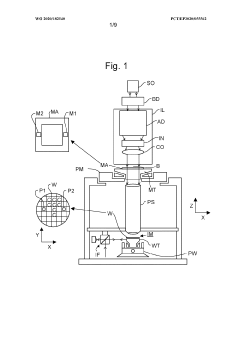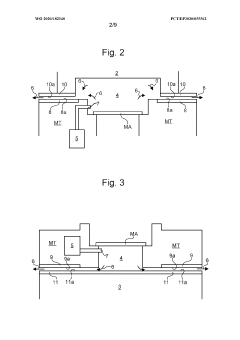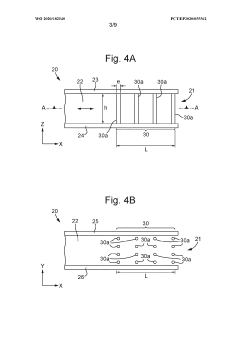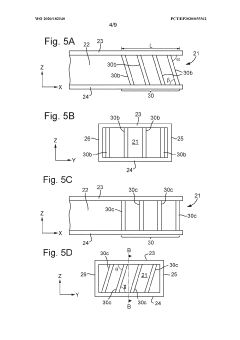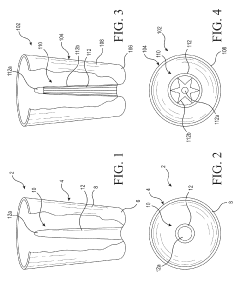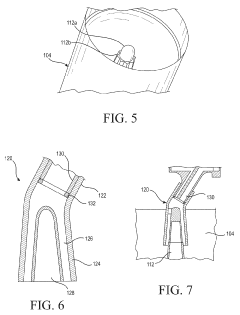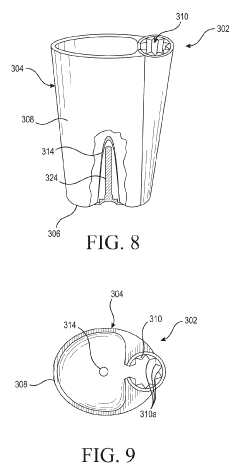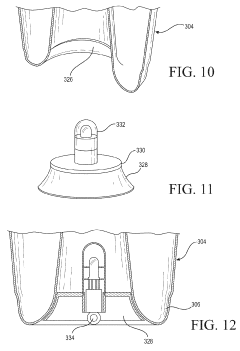Laminar Flow in Water Distribution Systems: A Guide
JUL 10, 20259 MIN READ
Generate Your Research Report Instantly with AI Agent
Patsnap Eureka helps you evaluate technical feasibility & market potential.
Laminar Flow Fundamentals and Objectives
Laminar flow in water distribution systems has been a subject of extensive research and development over the past century. This flow regime, characterized by smooth and predictable fluid motion, plays a crucial role in the efficient and safe distribution of water in urban and rural settings. The evolution of laminar flow technology in water systems has been driven by the need for improved water quality, energy efficiency, and system reliability.
The primary objective of studying laminar flow in water distribution systems is to optimize the design and operation of these networks. By understanding the principles of laminar flow, engineers and water management professionals can develop more effective strategies for controlling water pressure, reducing energy consumption, and minimizing water loss through leaks and inefficiencies. Additionally, maintaining laminar flow conditions helps prevent the formation of biofilms and reduces the risk of contamination, thereby enhancing water quality and public health.
Recent technological advancements have significantly contributed to our understanding of laminar flow dynamics in complex pipe networks. Computational fluid dynamics (CFD) simulations and advanced monitoring systems have enabled more accurate predictions of flow behavior under various conditions. These tools have become invaluable in the design and management of water distribution systems, allowing for proactive maintenance and optimization of network performance.
The trend towards smart water systems has further emphasized the importance of laminar flow control. By integrating sensors, data analytics, and automated control systems, water utilities can now maintain optimal flow conditions in real-time, responding to changes in demand and system parameters. This not only improves overall system efficiency but also contributes to the sustainability of water resources by reducing waste and energy consumption.
Looking ahead, the field of laminar flow in water distribution systems is expected to continue evolving. Emerging technologies such as nanotechnology for pipe surface treatments and advanced materials for pipe construction promise to enhance laminar flow characteristics further. Additionally, the integration of artificial intelligence and machine learning algorithms is anticipated to revolutionize flow prediction and control strategies, leading to more resilient and adaptive water distribution networks.
As we progress, the goals for laminar flow research in water distribution systems include developing more sophisticated modeling techniques, improving real-time monitoring capabilities, and creating innovative solutions for maintaining laminar flow in increasingly complex and aging infrastructure. These advancements will be crucial in addressing the challenges of urbanization, climate change, and growing water scarcity, ensuring the sustainable and efficient distribution of this vital resource to communities worldwide.
The primary objective of studying laminar flow in water distribution systems is to optimize the design and operation of these networks. By understanding the principles of laminar flow, engineers and water management professionals can develop more effective strategies for controlling water pressure, reducing energy consumption, and minimizing water loss through leaks and inefficiencies. Additionally, maintaining laminar flow conditions helps prevent the formation of biofilms and reduces the risk of contamination, thereby enhancing water quality and public health.
Recent technological advancements have significantly contributed to our understanding of laminar flow dynamics in complex pipe networks. Computational fluid dynamics (CFD) simulations and advanced monitoring systems have enabled more accurate predictions of flow behavior under various conditions. These tools have become invaluable in the design and management of water distribution systems, allowing for proactive maintenance and optimization of network performance.
The trend towards smart water systems has further emphasized the importance of laminar flow control. By integrating sensors, data analytics, and automated control systems, water utilities can now maintain optimal flow conditions in real-time, responding to changes in demand and system parameters. This not only improves overall system efficiency but also contributes to the sustainability of water resources by reducing waste and energy consumption.
Looking ahead, the field of laminar flow in water distribution systems is expected to continue evolving. Emerging technologies such as nanotechnology for pipe surface treatments and advanced materials for pipe construction promise to enhance laminar flow characteristics further. Additionally, the integration of artificial intelligence and machine learning algorithms is anticipated to revolutionize flow prediction and control strategies, leading to more resilient and adaptive water distribution networks.
As we progress, the goals for laminar flow research in water distribution systems include developing more sophisticated modeling techniques, improving real-time monitoring capabilities, and creating innovative solutions for maintaining laminar flow in increasingly complex and aging infrastructure. These advancements will be crucial in addressing the challenges of urbanization, climate change, and growing water scarcity, ensuring the sustainable and efficient distribution of this vital resource to communities worldwide.
Water Distribution Market Analysis
The water distribution market is experiencing significant growth and transformation, driven by urbanization, aging infrastructure, and increasing demand for efficient water management systems. This market encompasses a wide range of products and services, including pipes, valves, pumps, meters, and advanced monitoring systems. The global water distribution market is projected to expand steadily over the coming years, with a particular focus on smart water management solutions and sustainable practices.
One of the key drivers of market growth is the urgent need to upgrade and replace aging water infrastructure in many developed countries. In the United States alone, the American Society of Civil Engineers estimates that there is a water main break every two minutes, highlighting the critical need for investment in modernization. This presents substantial opportunities for companies specializing in trenchless technologies, leak detection systems, and advanced pipe materials.
Emerging economies are also contributing significantly to market expansion. Rapid urbanization and industrialization in countries like China, India, and Brazil are fueling demand for new water distribution networks and improved water quality management systems. These markets are particularly interested in cost-effective solutions that can be rapidly deployed to meet the needs of growing populations.
The adoption of smart water technologies is a major trend shaping the water distribution market. Internet of Things (IoT) enabled devices, advanced sensors, and data analytics platforms are being increasingly integrated into water distribution systems to optimize operations, reduce water loss, and improve overall efficiency. This shift towards digital solutions is creating new opportunities for technology companies and traditional water infrastructure providers alike.
Environmental concerns and water scarcity issues are driving innovation in water conservation technologies. There is growing demand for solutions that can help utilities and municipalities reduce non-revenue water, improve leak detection, and implement more sustainable water management practices. This trend is fostering the development of new materials, such as self-healing pipes, and advanced monitoring systems that can detect even minor leaks in real-time.
The competitive landscape of the water distribution market is diverse, with a mix of large multinational corporations, specialized equipment manufacturers, and innovative startups. Key players are increasingly focusing on research and development to gain a competitive edge, with particular emphasis on developing solutions that address the challenges of laminar flow in water distribution systems.
One of the key drivers of market growth is the urgent need to upgrade and replace aging water infrastructure in many developed countries. In the United States alone, the American Society of Civil Engineers estimates that there is a water main break every two minutes, highlighting the critical need for investment in modernization. This presents substantial opportunities for companies specializing in trenchless technologies, leak detection systems, and advanced pipe materials.
Emerging economies are also contributing significantly to market expansion. Rapid urbanization and industrialization in countries like China, India, and Brazil are fueling demand for new water distribution networks and improved water quality management systems. These markets are particularly interested in cost-effective solutions that can be rapidly deployed to meet the needs of growing populations.
The adoption of smart water technologies is a major trend shaping the water distribution market. Internet of Things (IoT) enabled devices, advanced sensors, and data analytics platforms are being increasingly integrated into water distribution systems to optimize operations, reduce water loss, and improve overall efficiency. This shift towards digital solutions is creating new opportunities for technology companies and traditional water infrastructure providers alike.
Environmental concerns and water scarcity issues are driving innovation in water conservation technologies. There is growing demand for solutions that can help utilities and municipalities reduce non-revenue water, improve leak detection, and implement more sustainable water management practices. This trend is fostering the development of new materials, such as self-healing pipes, and advanced monitoring systems that can detect even minor leaks in real-time.
The competitive landscape of the water distribution market is diverse, with a mix of large multinational corporations, specialized equipment manufacturers, and innovative startups. Key players are increasingly focusing on research and development to gain a competitive edge, with particular emphasis on developing solutions that address the challenges of laminar flow in water distribution systems.
Laminar Flow Challenges in Water Systems
Laminar flow in water distribution systems presents significant challenges that impact system efficiency, water quality, and overall performance. The primary issue stems from the nature of laminar flow itself, characterized by smooth, predictable fluid motion with minimal mixing between adjacent layers. In water distribution networks, this flow regime can lead to several complications.
One of the foremost challenges is the reduced efficiency in water transport. Laminar flow typically occurs at lower flow rates, which can result in decreased water delivery capacity. This inefficiency may necessitate larger pipe diameters or increased pumping power to maintain adequate water supply, both of which can significantly increase infrastructure costs and energy consumption.
Water quality is another critical concern associated with laminar flow. The lack of turbulent mixing can lead to stagnation zones within pipes, where contaminants and sediments may accumulate. This phenomenon can promote bacterial growth and biofilm formation, potentially compromising the safety and quality of the distributed water. Additionally, the reduced mixing can affect the uniform distribution of disinfectants, such as chlorine, throughout the system, potentially leaving some areas vulnerable to microbial contamination.
The prediction and modeling of laminar flow in complex water distribution networks pose substantial challenges for engineers and system designers. Traditional hydraulic models often assume turbulent flow conditions, which are more common in larger water mains. However, in smaller pipes or during periods of low demand, laminar flow can occur, necessitating more sophisticated modeling approaches to accurately predict system behavior.
Temperature variations within the distribution system can further complicate laminar flow dynamics. As water temperature changes, its viscosity is affected, which in turn influences the flow regime. This temperature dependence can lead to seasonal variations in system performance and water quality, requiring adaptive management strategies.
The transition between laminar and turbulent flow regimes presents another set of challenges. In real-world distribution systems, flow conditions can fluctuate, potentially causing frequent shifts between laminar and turbulent states. These transitions can lead to unpredictable hydraulic behavior, affecting pressure management and flow control strategies.
Addressing these challenges requires a multifaceted approach, combining advanced modeling techniques, innovative pipe designs, and smart monitoring systems. Research into surface modifications that can induce controlled turbulence even at low flow rates shows promise. Additionally, the development of adaptive control systems that can optimize flow conditions based on real-time demand and water quality parameters may offer solutions to mitigate the negative impacts of laminar flow in water distribution systems.
One of the foremost challenges is the reduced efficiency in water transport. Laminar flow typically occurs at lower flow rates, which can result in decreased water delivery capacity. This inefficiency may necessitate larger pipe diameters or increased pumping power to maintain adequate water supply, both of which can significantly increase infrastructure costs and energy consumption.
Water quality is another critical concern associated with laminar flow. The lack of turbulent mixing can lead to stagnation zones within pipes, where contaminants and sediments may accumulate. This phenomenon can promote bacterial growth and biofilm formation, potentially compromising the safety and quality of the distributed water. Additionally, the reduced mixing can affect the uniform distribution of disinfectants, such as chlorine, throughout the system, potentially leaving some areas vulnerable to microbial contamination.
The prediction and modeling of laminar flow in complex water distribution networks pose substantial challenges for engineers and system designers. Traditional hydraulic models often assume turbulent flow conditions, which are more common in larger water mains. However, in smaller pipes or during periods of low demand, laminar flow can occur, necessitating more sophisticated modeling approaches to accurately predict system behavior.
Temperature variations within the distribution system can further complicate laminar flow dynamics. As water temperature changes, its viscosity is affected, which in turn influences the flow regime. This temperature dependence can lead to seasonal variations in system performance and water quality, requiring adaptive management strategies.
The transition between laminar and turbulent flow regimes presents another set of challenges. In real-world distribution systems, flow conditions can fluctuate, potentially causing frequent shifts between laminar and turbulent states. These transitions can lead to unpredictable hydraulic behavior, affecting pressure management and flow control strategies.
Addressing these challenges requires a multifaceted approach, combining advanced modeling techniques, innovative pipe designs, and smart monitoring systems. Research into surface modifications that can induce controlled turbulence even at low flow rates shows promise. Additionally, the development of adaptive control systems that can optimize flow conditions based on real-time demand and water quality parameters may offer solutions to mitigate the negative impacts of laminar flow in water distribution systems.
Current Laminar Flow Management Solutions
01 Measurement and analysis of laminar flow characteristics
Various methods and devices are used to measure and analyze laminar flow characteristics. These include optical systems, sensors, and computational techniques to determine flow patterns, velocity profiles, and other properties of laminar flow. Such measurements are crucial for understanding and optimizing fluid dynamics in various applications.- Measurement and characterization of laminar flow: Various methods and devices are used to measure and characterize laminar flow characteristics. These include optical systems, sensors, and flow meters that can detect and analyze flow patterns, velocity profiles, and other parameters associated with laminar flow. Such measurements are crucial for understanding and optimizing fluid dynamics in various applications.
- Control and manipulation of laminar flow: Techniques and systems are developed to control and manipulate laminar flow characteristics. This includes the use of specialized nozzles, flow conditioners, and other devices that can modify flow patterns, reduce turbulence, and maintain laminar conditions. These methods are particularly important in applications requiring precise fluid control.
- Laminar flow in aerodynamics and vehicle design: Laminar flow principles are applied in aerodynamics and vehicle design to improve efficiency and performance. This involves designing surfaces and structures that promote laminar flow, reducing drag and improving fuel efficiency. Various techniques are used to maintain laminar flow over wings, fuselages, and other vehicle components.
- Laminar flow in fluid handling and processing: Laminar flow characteristics are utilized in fluid handling and processing applications. This includes the design of pipes, channels, and vessels that maintain laminar flow conditions for improved efficiency in fluid transport, mixing, and separation processes. Special attention is given to preventing transition to turbulent flow in these systems.
- Modeling and simulation of laminar flow: Advanced modeling and simulation techniques are employed to study and predict laminar flow behavior. This involves the use of computational fluid dynamics (CFD) and other numerical methods to analyze flow characteristics under various conditions. These models help in designing and optimizing systems that rely on laminar flow properties.
02 Control and manipulation of laminar flow
Techniques and systems are developed to control and manipulate laminar flow characteristics. This includes the use of specialized nozzles, flow conditioners, and other devices to maintain or modify laminar flow conditions. These methods are important in applications such as spray systems, fluid dispensing, and aerodynamics.Expand Specific Solutions03 Laminar flow in microfluidic devices
Microfluidic devices utilize laminar flow characteristics for various applications. These devices exploit the predictable behavior of laminar flow at small scales to perform precise fluid handling, mixing, and separation tasks. This is particularly useful in fields such as biomedical research, chemical analysis, and lab-on-a-chip technologies.Expand Specific Solutions04 Laminar flow in heat transfer applications
Laminar flow characteristics are utilized in heat transfer applications to improve efficiency and control. This includes the design of heat exchangers, cooling systems, and thermal management solutions that leverage the predictable nature of laminar flow to enhance heat transfer rates and temperature control.Expand Specific Solutions05 Laminar flow in aerodynamics and fluid dynamics research
Research in aerodynamics and fluid dynamics often focuses on laminar flow characteristics. This includes studies of boundary layer behavior, transition to turbulence, and the development of low-drag surfaces. Understanding and controlling laminar flow is crucial for improving the performance of aircraft, vehicles, and other systems that interact with fluids.Expand Specific Solutions
Key Players in Water Distribution Industry
The laminar flow technology in water distribution systems is in a mature stage of development, with a well-established market and significant industry players. The global water distribution systems market is substantial, valued at billions of dollars annually, with steady growth projected. Companies like Pentair Water Pool & Spa, Hayward Industries, and Rheem Manufacturing Co. have developed advanced laminar flow solutions, indicating a high level of technological maturity. Research institutions such as the University of Washington and the National University of Singapore continue to refine and optimize laminar flow techniques, while industry leaders like PepsiCo and LG Electronics incorporate these technologies into their water-related products and processes, demonstrating widespread adoption across various sectors.
China Institute of Water Resources & Hydropower Research
Technical Solution: The China Institute of Water Resources & Hydropower Research has developed advanced computational fluid dynamics (CFD) models to simulate laminar flow in water distribution systems. Their approach incorporates multi-scale modeling techniques to accurately represent flow behavior from pipe networks to individual pipe segments[1]. The institute has also implemented machine learning algorithms to optimize system design and predict flow patterns under various conditions, improving overall system efficiency[3]. Additionally, they have developed novel sensor technologies for real-time monitoring of flow characteristics, enabling proactive maintenance and reducing water loss[5].
Strengths: Comprehensive modeling capabilities, integration of AI for optimization, and advanced monitoring systems. Weaknesses: May require significant computational resources and specialized expertise for implementation.
Franke Technology & Trademark Ltd.
Technical Solution: Franke Technology & Trademark Ltd. has pioneered the development of innovative pipe materials and surface treatments to promote laminar flow in water distribution systems. Their proprietary coating technology reduces pipe wall roughness, minimizing turbulence and enhancing flow efficiency[2]. The company has also designed advanced pipe fittings and junctions that maintain laminar flow characteristics at critical points in the distribution network[4]. Franke's solutions incorporate smart valves and pressure regulators that dynamically adjust flow conditions to maintain laminar regimes across varying demand scenarios[6].
Strengths: Innovative materials science approach, holistic system design considering critical components. Weaknesses: May require significant infrastructure upgrades for existing systems to fully benefit.
Innovations in Laminar Flow Control
Providing substantially laminar fluid flow in a lithographic apparatus
PatentWO2020182540A1
Innovation
- A device providing substantially laminar fluid flow in a lithographic apparatus, featuring a flow laminating portion with a plurality of pillars, sub-channels, or a porous layer to optimize fluid flow and reduce contamination, manufactured using additive manufacturing for reduced costs and lead times.
Container with laminar flow
PatentActiveUS20190261793A1
Innovation
- A container with a laminar flow device, such as a tapered conical projection or fluted inner surface, that directs fluid to the bottom to minimize turbulence and foam formation, combined with a flow director for beer taps to ensure smooth dispensing.
Regulatory Framework for Water Systems
The regulatory framework for water distribution systems plays a crucial role in ensuring the safety, quality, and efficiency of water supply. In the context of laminar flow, regulations are designed to maintain optimal hydraulic conditions and prevent potential health risks associated with stagnant water or contamination.
At the federal level, the Safe Drinking Water Act (SDWA) sets the foundation for water quality standards and treatment requirements. The Environmental Protection Agency (EPA) enforces these regulations, which include specific provisions related to flow characteristics in distribution systems. The EPA's Surface Water Treatment Rule and Disinfectants and Disinfection Byproducts Rule both address aspects of water flow that can impact water quality and safety.
State-level regulations often build upon federal standards, adapting them to local conditions and needs. For instance, California's Water Code includes detailed requirements for water pressure and flow rates in distribution systems, which directly influence the likelihood of laminar flow conditions. Similarly, New York's Public Health Law contains provisions for maintaining adequate water circulation to prevent stagnation and ensure consistent water quality throughout the distribution network.
Local municipalities and water utilities are typically responsible for implementing and enforcing these regulations. They must develop and maintain water distribution systems that comply with both state and federal standards. This includes regular monitoring of flow conditions, pressure management, and water quality testing to ensure that laminar flow is maintained where appropriate and that water quality is not compromised.
The American Water Works Association (AWWA) provides industry standards and best practices that complement regulatory requirements. Their guidelines on distribution system design, operation, and maintenance often incorporate considerations for flow characteristics, including the management of laminar flow conditions.
International regulations, such as those set by the World Health Organization (WHO), also influence water distribution system standards globally. While not directly enforceable in the United States, these guidelines often inform domestic policy and regulatory decisions, particularly in areas related to emerging contaminants and advanced flow management techniques.
Regulatory compliance in water distribution systems often requires a multifaceted approach, combining engineering controls, operational procedures, and monitoring protocols. Water utilities must demonstrate ongoing compliance through regular reporting and audits, ensuring that laminar flow conditions are appropriately managed to maintain water quality and system efficiency.
At the federal level, the Safe Drinking Water Act (SDWA) sets the foundation for water quality standards and treatment requirements. The Environmental Protection Agency (EPA) enforces these regulations, which include specific provisions related to flow characteristics in distribution systems. The EPA's Surface Water Treatment Rule and Disinfectants and Disinfection Byproducts Rule both address aspects of water flow that can impact water quality and safety.
State-level regulations often build upon federal standards, adapting them to local conditions and needs. For instance, California's Water Code includes detailed requirements for water pressure and flow rates in distribution systems, which directly influence the likelihood of laminar flow conditions. Similarly, New York's Public Health Law contains provisions for maintaining adequate water circulation to prevent stagnation and ensure consistent water quality throughout the distribution network.
Local municipalities and water utilities are typically responsible for implementing and enforcing these regulations. They must develop and maintain water distribution systems that comply with both state and federal standards. This includes regular monitoring of flow conditions, pressure management, and water quality testing to ensure that laminar flow is maintained where appropriate and that water quality is not compromised.
The American Water Works Association (AWWA) provides industry standards and best practices that complement regulatory requirements. Their guidelines on distribution system design, operation, and maintenance often incorporate considerations for flow characteristics, including the management of laminar flow conditions.
International regulations, such as those set by the World Health Organization (WHO), also influence water distribution system standards globally. While not directly enforceable in the United States, these guidelines often inform domestic policy and regulatory decisions, particularly in areas related to emerging contaminants and advanced flow management techniques.
Regulatory compliance in water distribution systems often requires a multifaceted approach, combining engineering controls, operational procedures, and monitoring protocols. Water utilities must demonstrate ongoing compliance through regular reporting and audits, ensuring that laminar flow conditions are appropriately managed to maintain water quality and system efficiency.
Environmental Impact of Flow Management
The environmental impact of flow management in water distribution systems is a critical consideration for sustainable urban development. Laminar flow, characterized by smooth and predictable fluid motion, plays a significant role in minimizing energy consumption and reducing the environmental footprint of water distribution networks.
One of the primary environmental benefits of maintaining laminar flow is the reduction in energy requirements for pumping water through the system. When flow remains laminar, friction losses are minimized, resulting in lower power consumption by pumps and associated decreases in greenhouse gas emissions from energy production. This energy efficiency contributes to the overall sustainability of water distribution infrastructure and aligns with global efforts to mitigate climate change.
Furthermore, laminar flow conditions help preserve water quality by reducing the potential for sediment resuspension and biofilm detachment within pipes. This leads to decreased need for chemical treatments and disinfectants, thereby minimizing the introduction of potentially harmful substances into the environment. The reduced use of chemicals also translates to lower production and transportation-related emissions associated with water treatment processes.
Proper flow management that maintains laminar conditions can extend the lifespan of water distribution infrastructure. By reducing wear and tear on pipes and fittings, the frequency of repairs and replacements is decreased. This not only conserves resources but also minimizes the environmental impact associated with manufacturing and installing new components.
In urban settings, laminar flow management contributes to noise reduction in water distribution systems. The absence of turbulent flow reduces vibrations and water hammer effects, leading to quieter operation. This acoustic benefit enhances the quality of life in urban environments and reduces noise pollution, which can have detrimental effects on both human and wildlife populations.
Additionally, effective flow management can optimize water distribution efficiency, reducing water losses through leaks and improving overall system performance. This conservation of water resources is particularly crucial in regions facing water scarcity, as it helps maintain ecological balance and protects aquatic ecosystems from excessive water extraction.
The implementation of smart flow management systems, which often rely on maintaining laminar flow conditions, can lead to more responsive and adaptive water distribution networks. These systems can quickly detect and respond to changes in demand or potential leaks, further enhancing water conservation efforts and reducing the environmental impact of water loss and associated energy waste.
One of the primary environmental benefits of maintaining laminar flow is the reduction in energy requirements for pumping water through the system. When flow remains laminar, friction losses are minimized, resulting in lower power consumption by pumps and associated decreases in greenhouse gas emissions from energy production. This energy efficiency contributes to the overall sustainability of water distribution infrastructure and aligns with global efforts to mitigate climate change.
Furthermore, laminar flow conditions help preserve water quality by reducing the potential for sediment resuspension and biofilm detachment within pipes. This leads to decreased need for chemical treatments and disinfectants, thereby minimizing the introduction of potentially harmful substances into the environment. The reduced use of chemicals also translates to lower production and transportation-related emissions associated with water treatment processes.
Proper flow management that maintains laminar conditions can extend the lifespan of water distribution infrastructure. By reducing wear and tear on pipes and fittings, the frequency of repairs and replacements is decreased. This not only conserves resources but also minimizes the environmental impact associated with manufacturing and installing new components.
In urban settings, laminar flow management contributes to noise reduction in water distribution systems. The absence of turbulent flow reduces vibrations and water hammer effects, leading to quieter operation. This acoustic benefit enhances the quality of life in urban environments and reduces noise pollution, which can have detrimental effects on both human and wildlife populations.
Additionally, effective flow management can optimize water distribution efficiency, reducing water losses through leaks and improving overall system performance. This conservation of water resources is particularly crucial in regions facing water scarcity, as it helps maintain ecological balance and protects aquatic ecosystems from excessive water extraction.
The implementation of smart flow management systems, which often rely on maintaining laminar flow conditions, can lead to more responsive and adaptive water distribution networks. These systems can quickly detect and respond to changes in demand or potential leaks, further enhancing water conservation efforts and reducing the environmental impact of water loss and associated energy waste.
Unlock deeper insights with Patsnap Eureka Quick Research — get a full tech report to explore trends and direct your research. Try now!
Generate Your Research Report Instantly with AI Agent
Supercharge your innovation with Patsnap Eureka AI Agent Platform!
